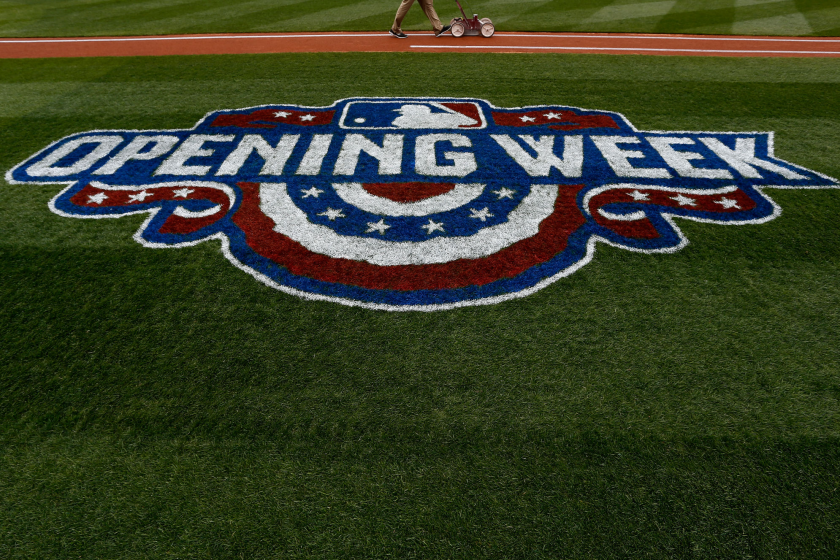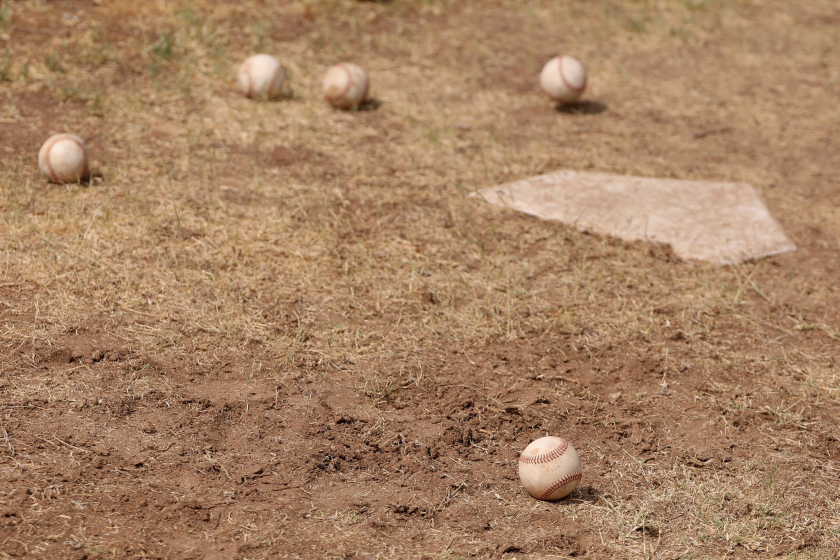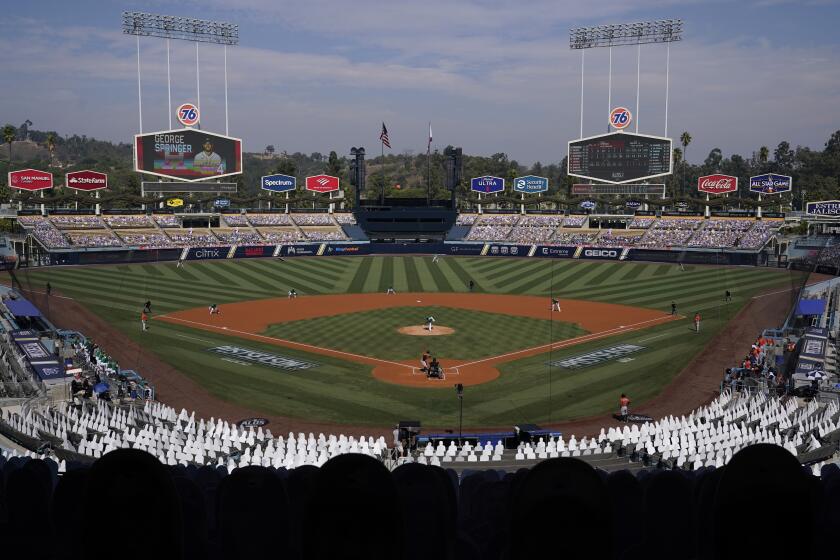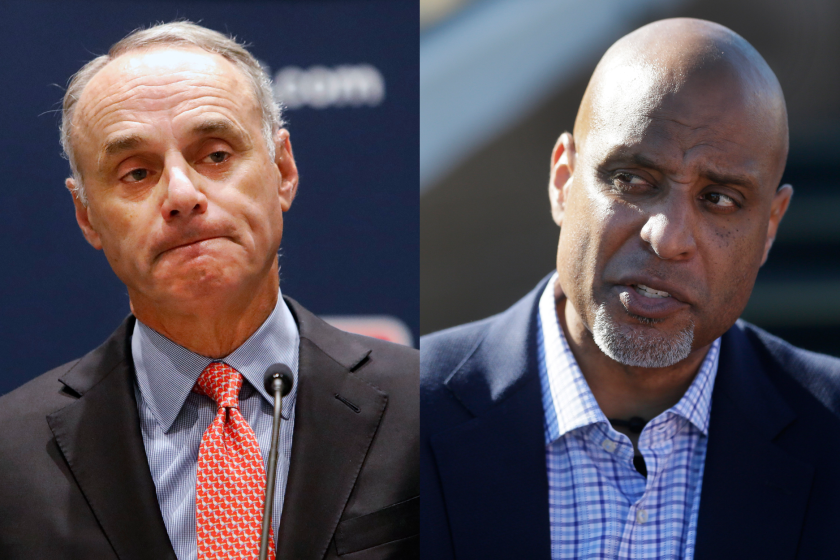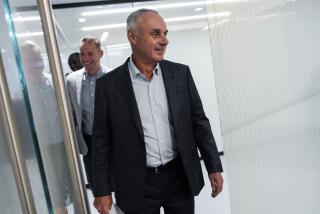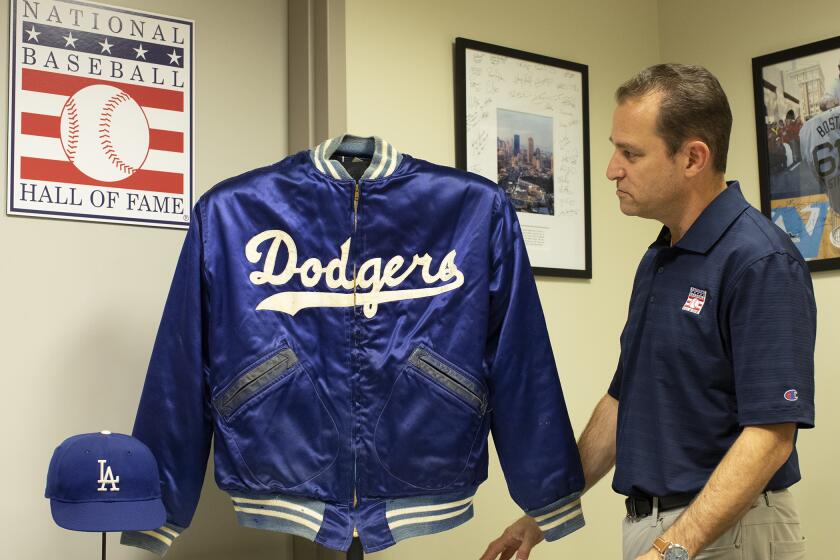Tone is set for MLB and players’ union CBA negotiations, and it isn’t amicable
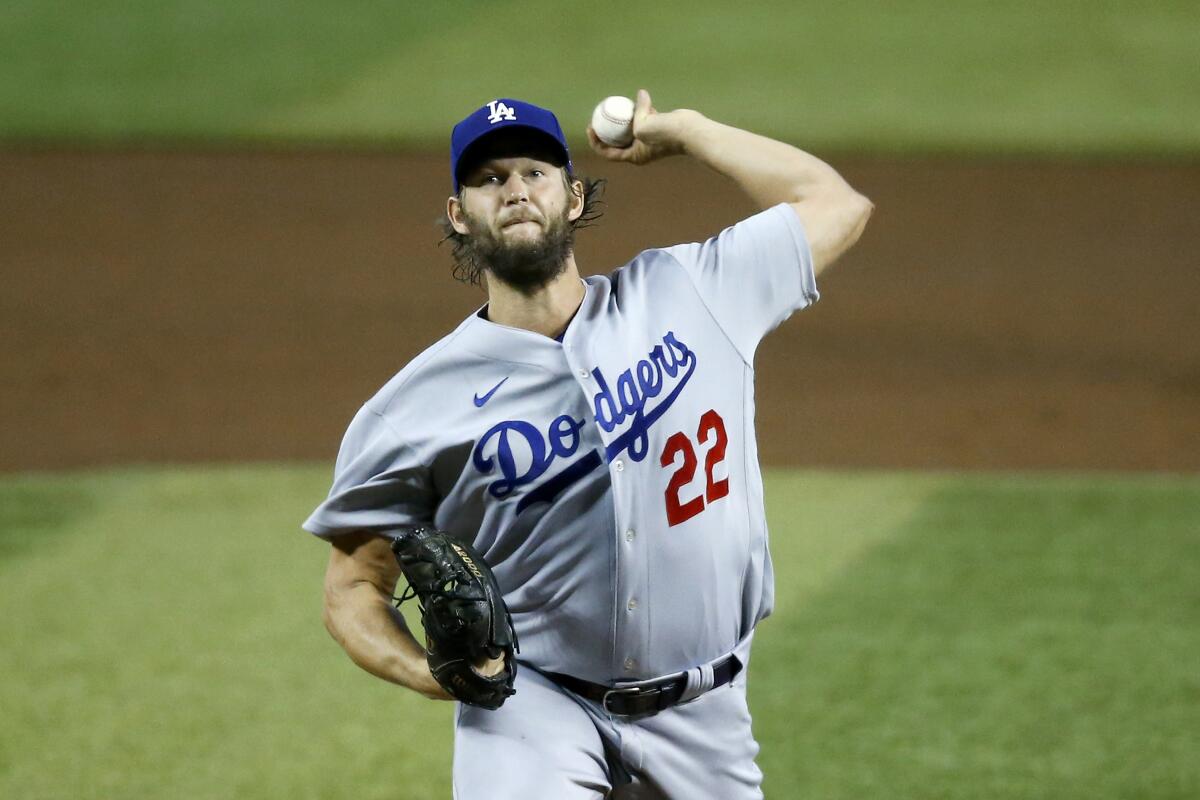
- Share via
It is one week until the first day of the last season under baseball’s current collective bargaining agreement, and Tony Clark has a problem. Or a win. Or both. These days, it can be tough to tell.
Zac Gallen is hurt. He is a pitcher, probably the best the Arizona Diamondbacks have, but he might start the season on the injured list because he suffered a stress fracture — while working on his hitting.
Gallen did not want to hit this season. The owners and the players agreed last year to use a designated hitter in every game, and they could have done the same this year.
The universal designated hitter is not even controversial any more. According to a Seton Hall poll released Thursday, “avid fans” prefer the DH in the National League: 57% approve, 17% disapprove and 26% did not care. Among the general public, 29% approved, 14% disapproved and 57% did not care. That last number should frighten both the owners and the players, but we digress.
The 2021 MLB season will again feature seven-inning doubleheaders and runners on second base to start extra innings under approved health protocols.
Clark is the executive director of the players’ union. As the league office and the union negotiated health and safety protocols for this second pandemic season, the union kept putting “universal DH” in its drafts of the protocols. The league office kept removing “universal DH” from its drafts. The default setting was the current collective bargaining agreement, which does not include a universal DH.
“The only thing keeping the DH from being a part of the fabric of the 2021 season is the decision by the league not to have it,” Clark said Thursday.
The owners asked the players to approve an expanded postseason in exchange for the universal DH. The players declined, preferring to reserve expanded playoffs as a potential bargaining chip for this year’s collective bargaining negotiations.
For general managers and their analytics staffs, churning out recommendations based on risk management, the DH is a no-brainer. Why pay a pitcher millions to pitch and risk losing him because of two weak at-bats every fifth day? With the league striving to reduce home runs, walks and strikeouts and increase singles, doubles and stolen bases, why waste at-bats on a pitcher bunting or striking out? Why should owners insist players make a concession to give general managers what they want?
“While there are concerns related to other areas that we may or may not have been able to find disagreement on,” Clark said, “as a health and safety issue, and against the backdrop of some of the concerns the industry is trying to address, it would seem as if the DH would be beneficial for all involved.”
Major League Baseball players turned down a proposal by the league to delay the beginning spring training and the regular season for a litany of reasons.
Gallen’s injury might represent a hollow vindication of the union’s position. Clark said — and an MLB official confirmed — that there have been no discussions about a last-minute addition of the DH to the NL this season.
As a summer of collective bargaining approaches, there is a lingering concern about how some league officials characterized the union in the wake of last winter’s negotiations: obstinate, obstructionist, more interested in saying no than in making a deal.
When the owners offered money in exchange for expanded playoffs, the union preferred not to negotiate over the amount. When the owners made multiple proposals to delay the start of this season, with the thought that another month of vaccinations would make everyone safer and allow for larger crowds, the union preferred to start on time (and, as of last week, the positivity rate for MLB coronavirus tests this spring was 0.05%).
“When there are fundamental disagreements about the best interests of the game, there’s no reason why work can’t continue to be done to try to find that common ground, and have it be done out of the public eye,” Clark said. “Although we don’t go out and suggest the league is obstructionist when they don’t agree with the positions we are taking, it seems to be their current M.O., and that’s unfortunate.”
Single-game Dodgers tickets are expected to go on sale by the end of March, following the completion of the re-seating process for season-ticket holders.
The collective bargaining agreement expires Dec. 1, and negotiations on a new one are expected to start after the regular season does. Clark outlined the goals for the union.
“Establishing a more competitive environment, or climate, we believe, will help drive industry growth, and that’s going to benefit fans and players and management alike,” he said. “We believe that clubs should be incentivized for competing and succeeding, rather than rewarded for repeatedly losing. We believe that making adjustments to the system such that younger players who are producing and providing increasing value for their clubs and for our game are more fairly compensated.”
There are no easy fixes. For instance, Dodgers pitcher Trevor Bauer is set to make about as much money as all the Pittsburgh Pirates this season. According to Cot’s Baseball Contracts, the payrolls of the Pirates, Baltimore Orioles, Cleveland Orioles and Miami Marlins each project to less than 25% of the Dodgers’ payroll.
A logical reaction would be to mandate a minimum team payroll. The union probably would have a philosophical objection, as it might be illogical to support a salary floor and oppose a salary cap. But all those efficiency experts in front offices might recommend spending the required money on long-term contracts for younger players, which probably would not help the veteran free agents that languish on the market every winter.
The Dodgers, New York Yankees, San Francisco Giants and other large-market teams might balk at any proposal that would mandate they help fund the minimum payrolls by sharing more of their revenue, to a point where the Dodgers might effectively be paying Pirates players. In addition, mandating a certain amount of spending might trigger unintended consequences in how that money would be spent.
Clark said the grievance the union filed three years ago — challenging whether the Pirates, Marlins, Oakland Athletics and Tampa Bay Rays properly used revenue-sharing money — still has not been resolved. He also said the union has not filed a grievance challenging whether the owners negotiated in good faith during last year’s return-to-play discussions, but he said such a grievance remains under consideration.
Earlier this week, MLB team owners and players seemed ready to agree to a deal to start the season, but it appears both sides misunderstood one another.
The union has assembled a fund to assist players in the event they strike or, more likely, the owners lock them out.
“Players are committed to seeking significant improvements to the current system, but we’re not trying to bring about a work stoppage, and we’re looking to make a deal without one,” Clark said. “We look forward to finding common ground on a fair and equitable deal by the expiration of this current one.”
As the pace of vaccinations increases, Clark said he believes every player that wishes to be vaccinated should be able to do so within a month or so. A league official said Thursday that vaccination would be “state-based” and “handled on a club-by-club basis.”
Arizona is one of six states vaccinating all adults now, and California officials said Thursday all adults would become eligible April 15. President Biden has asked that every state make all adults eligible no later than May 1.
In the second half of the season, perhaps, teams can play to full capacity. And, if so, teams would have removed the buffer zone between fans and players, required under the league’s current health and safety protocols.
Nothing says a day at the ballpark quite like a kid scrambling down to the front row to get an autograph from his or her favorite player.
“We would love to see it, to have an opportunity to interact more closely with our fans,” Clark said. “Our players are as accessible as any players in any sport.”
If that happens this summer, that would be great. And, if that happens next April, because a work stoppage has been averted and the 2022 season starts on time, that would be nice too.
More to Read
Are you a true-blue fan?
Get our Dodgers Dugout newsletter for insights, news and much more.
You may occasionally receive promotional content from the Los Angeles Times.

